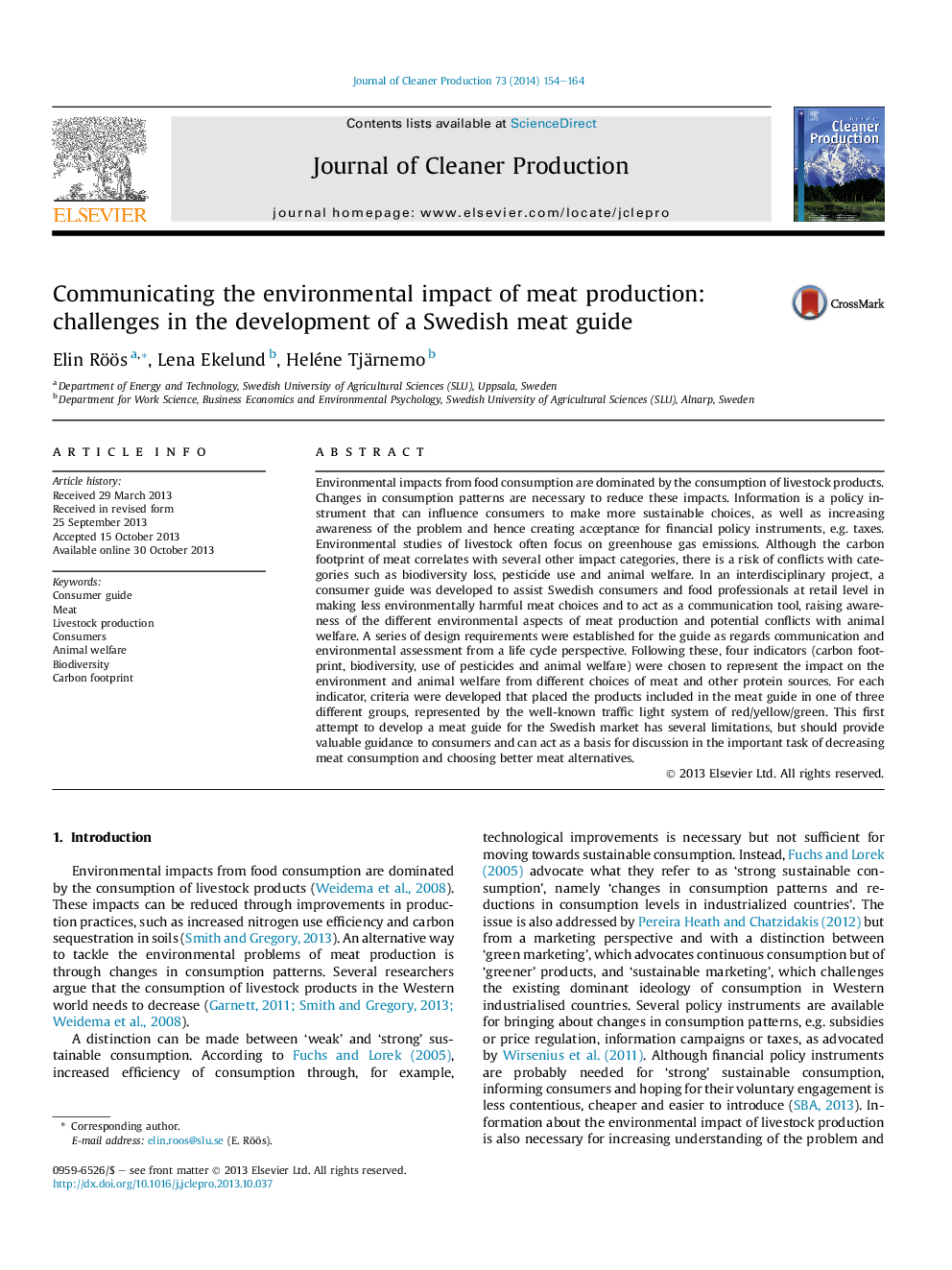| کد مقاله | کد نشریه | سال انتشار | مقاله انگلیسی | نسخه تمام متن |
|---|---|---|---|---|
| 8106339 | 1522173 | 2014 | 11 صفحه PDF | دانلود رایگان |
عنوان انگلیسی مقاله ISI
Communicating the environmental impact of meat production: challenges in the development of a Swedish meat guide
ترجمه فارسی عنوان
برقراری ارتباط با اثرات زیست محیطی تولید گوشت: چالش ها در توسعه راهنمای گوشت سوئدی
دانلود مقاله + سفارش ترجمه
دانلود مقاله ISI انگلیسی
رایگان برای ایرانیان
کلمات کلیدی
راهنمای مصرف کننده، گوشت تولید دام، مصرف کنندگان، رفاه حیوانات، تنوع زیستی، رد پای کربن،
ترجمه چکیده
اثرات زیست محیطی از مصرف مواد غذایی تحت تأثیر مصرف محصولات دام می باشد. تغییرات در الگوهای مصرف برای کاهش این اثرات ضروری است. اطلاعات یک ابزار سیاستی است که می تواند بر مشتریان تاثیر گذار باشد تا انتخاب های پایدار تر و همچنین افزایش آگاهی از مشکل و از این رو پذیرش ابزارهای سیاست مالی، مثلا مالیات. مطالعات زیست محیطی دام ها اغلب بر انتشار گازهای گلخانه ای تمرکز می کنند. با وجودی که ردیابی کربن گوشت با چندین طبقه تاثیر دیگر مرتبط است، خطر درگیری با مقوله هایی مانند از دست دادن تنوع زیستی، استفاده از آفت کش ها و رفاه حیوانات وجود دارد. در یک پروژه بین رشته ای، یک راهنمای مصرف کننده برای کمک به مصرف کنندگان سوئدی و متخصصان مواد غذایی در سطح خرده فروشی در ایجاد گزینه های گوشتی کمتر از محیط زیست مضر است و به عنوان ابزار ارتباطی عمل می کند، افزایش آگاهی از جنبه های زیست محیطی مختلف تولید گوشت و درگیری های بالقوه با حیوانات رفاه. مجموعه ای از الزامات طراحی برای راهنمایی در رابطه با ارتباطات و ارزیابی محیط زیست از منظر چرخه عمر ایجاد شده است. پس از این، چهار شاخص (رد پای کربن، تنوع زیستی، استفاده از آفت کش ها و رفاه حیوانات) برای نشان دادن تاثیر بر محیط زیست و رفاه حیوانات از انتخاب های مختلف گوشت و سایر منابع پروتئین انتخاب شد. برای هر شاخص، معیارهای توسعه یافتند که محصولات موجود در راهنمای گوشت را در یکی از سه گروه مختلف قرار دادند که توسط سیستم روشنایی قرمز / زرد / سبز شناخته شده است. این اولین تلاش برای ایجاد راهنمای گوشتی برای بازار سوئد دارای محدودیت های متعددی است، اما باید راهنمایی های ارزشمندی برای مصرف کنندگان ارائه دهد و می تواند به عنوان مبنایی برای بحث در کار مهم کاهش مصرف گوشت و انتخاب جایگزین های گوشتی بهتر عمل کند.
موضوعات مرتبط
مهندسی و علوم پایه
مهندسی انرژی
انرژی های تجدید پذیر، توسعه پایدار و محیط زیست
چکیده انگلیسی
Environmental impacts from food consumption are dominated by the consumption of livestock products. Changes in consumption patterns are necessary to reduce these impacts. Information is a policy instrument that can influence consumers to make more sustainable choices, as well as increasing awareness of the problem and hence creating acceptance for financial policy instruments, e.g. taxes. Environmental studies of livestock often focus on greenhouse gas emissions. Although the carbon footprint of meat correlates with several other impact categories, there is a risk of conflicts with categories such as biodiversity loss, pesticide use and animal welfare. In an interdisciplinary project, a consumer guide was developed to assist Swedish consumers and food professionals at retail level in making less environmentally harmful meat choices and to act as a communication tool, raising awareness of the different environmental aspects of meat production and potential conflicts with animal welfare. A series of design requirements were established for the guide as regards communication and environmental assessment from a life cycle perspective. Following these, four indicators (carbon footprint, biodiversity, use of pesticides and animal welfare) were chosen to represent the impact on the environment and animal welfare from different choices of meat and other protein sources. For each indicator, criteria were developed that placed the products included in the meat guide in one of three different groups, represented by the well-known traffic light system of red/yellow/green. This first attempt to develop a meat guide for the Swedish market has several limitations, but should provide valuable guidance to consumers and can act as a basis for discussion in the important task of decreasing meat consumption and choosing better meat alternatives.
ناشر
Database: Elsevier - ScienceDirect (ساینس دایرکت)
Journal: Journal of Cleaner Production - Volume 73, 15 June 2014, Pages 154-164
Journal: Journal of Cleaner Production - Volume 73, 15 June 2014, Pages 154-164
نویسندگان
Elin Röös, Lena Ekelund, Heléne Tjärnemo,
